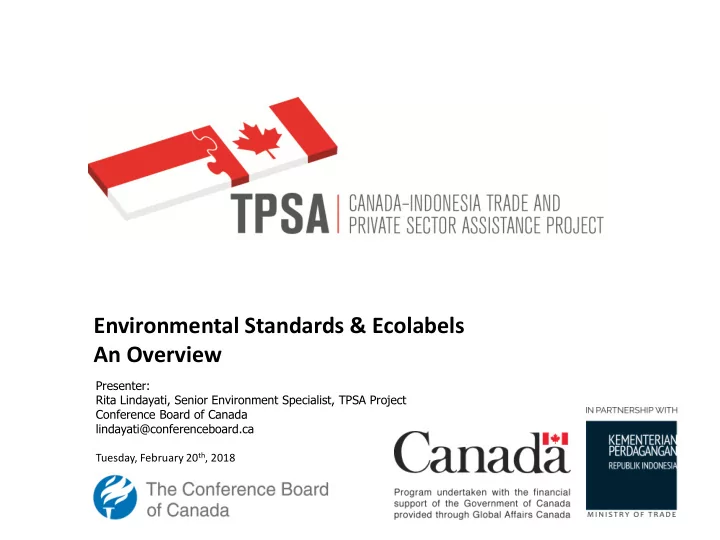

This programme has been made possible through the generous support of the Caribbean Export Development Agency and the Deutsche Gesellschaft für Internationale Zusammenarbeit (GIZ). Canada-Indonesia Trade and Private Sector Assistance Project (TPSA) \\\\\\\\\\\\\\\\\\ Environmental Standards & Ecolabels An Overview Presenter: Rita Lindayati, Senior Environment Specialist, TPSA Project Conference Board of Canada lindayati@conferenceboard.ca Tuesday, February 20 th , 2018
Standards are “agreed criteria by which a product or a service’s performance, its technical and physical characteristics, and/or the process, and conditions, under WHAT? which it has been produced or delivered, can be assessed.” (Nadvi and Waltring, 2001)
Global standards are important in smoothing trade relations and promoting efficient markets • Reduce transaction costs (by transmitting information efficiently) Why • Facilitate coordination and Im Important? communication between chain actors • Can be an important way to add value to a product • Lower risks for various actors in the chain Source: Nadvi and Waltring (2001)
Typology of Standards Standards can be distinguished according to the following criterion Geographical Regulatory Function Forms Coverage Scope reach implications generic, environment management sector process, al, social, standards, specific, national, legally product labour, company firm/value regional, mandatory, standards quality, safety codes, labels chain specific global voluntary Source: Nadvi and Waltring (2001)
• Growing consumer environmental awareness/sustainability issues Fact ctors • Globalization of production and trade contrib ibuting to • Concern over weak national the government capacity in environmental law enforcement (especially in proli liferation developing countries) of f glo lobal • Recognition of the limitations of global envir ironmental intergovernmental cooperation in promoting sustainable production and standards consumption
• Standards have become a major determinant of market access , particularly in high income market. • Many high margin market segments are defined by product and process standards (for example, organic foods) • In developing the capacity to achieve standards, many producers develop capabilities which enhance their efficiency and their capacity to systematically increased The Th productivity • Meeting standards is generally a costly process, and this can Im Importance of f act as a barrier to entry for small scale and informal Envir ironmental l producers . • Many standards require coordinated actions along the value Standards to St chain , and this systemic performance may be difficult to Develo lopin ing achieve. Countrie Co ies • Developing countries lack adequate technical infrastructure to engage in standard formulation, or promote compliance • Small firms/ producers in developing countries lack of technical and financial resources needed for compliance are the most disadvantaged in meeting global standards Source: Kaplinsky (2010: 1)
Types of f Actors Engaged in in Defining and Im Implementing St Standards Types of Actors Local/National Global Private Local or national firms, Trans-national trade associations and corporations, global certification firms certification firms Civil society Local or national NGOs, Global NGOs, international consumer groups and trade union federations trade unions Public Local and national International and regional government and standards organizations organizations Source: Nadvi and Waltring (2001)
The Dy Dynamic of of Environmental l St Standards an and Its Its Gr Growin ing Di Diversit ity NGO + business defined sector-specific codes/ labels Increasing complexity Increase of of Generic business network compliance defined standards arrangement requirements /governance Business sector specific codes/ labels Firm specific codes/ Vulnerability of labels lead firms to consumer and NGO pressures Source: Nadvi and Waltring (2001)
Ecola labels ls: An Overvie iew • "Ecolabelling" is a voluntary method of environmental performance certification. • An ecolabel identifies a product (i.e., good or service) that meets a wide range of environmental performance criteria or standards. • Ecolabel criteria usually focus on the lifecycle stages where the product has the highest environmental impact, and this differs from product to product. • (https://globalecolabelling.net/what-is-eco-labelling/) Ecolabels are tools to convey information to consumers about the environmental attributes of the product/ service There are over 400 ecolabels in today’s global market, see: http://www.ecolabelindex.com/ecolabels/ More information: http://www.globalecolabelling.net http://www.standardsmap.org
Types of f Environmental Perf rformance La Labelling (IS (ISO category ry) Type I • A voluntary, multiple-criteria based, third party program that awards a license which authorises the use of environmental labels on products indicating overall environmental preferability of a product within a product category based on life cycle considerations Type II • Informative environmental self-declaration claims Type III • Voluntary programs that provide quantified environmental data of a product, under pre-set categories of parameters set by a qualified third party and based on life cycle assessment, and verified by that or another qualified third party Source: https://globalecolabelling.net/what-is-eco-labelling/
Potentia ial l Driv rivers for r Bu Busin iness to Adopt Ce Cert rtif ific icatio ion • Reducing risk • Differentiating products from competitors • Finding new efficiency and cost saving opportunities • Ensuring long-term supply • Reputational gains • Potential price premium for the product Source: Golden (2010)
Example les Sustainable e com ompli liant producti tion as a per ercen entage of of glob global l producti tion 2008 & 2012 Commodity 2008 2012 S Coffee 15% 40% Cocoa 3% 22% Palm Oil 2% 15% Tea 6% 12% Cotton 1% 3% Sugar 1% 3% Soy Beans 2% 2% Source: Potts (2014)
Coffee production of major ecolabels 2008-2014 2500 2000 Thousands metric tons 1500 1000 500 0 4 C Fairtrade Organic Rainforest Alliance UTZ CAFÉ Practice 2008 2009 2010 2011 Source: International Trade Centre (2015)
Most popular ecolabels in Canada
Leading ec Le ecolabels in in maj ajor gr grocery ry stores in in Ot Ottawa, Can anad ada Major grocery Total Fairtrade Organic Rainforest CAFÉ Brands store brands Alliance Practices with (Starbuck) ecolabel Walmart 15 1 27% Loblaws 19 3 2 6 1 53% (2 Organic) (2 Fairtrade) Metro 21 1 1 5 1 33% (1 Organic) (1 Fairtrade) Food Basics 15 - - 2 - 13% Farm Boy 6 3 (1 1 2 83% Organic) Average 42% Source: Primary data from Ottawa major grocery stores (Rita Lindayati, March 2017) 21
Recommend
More recommend